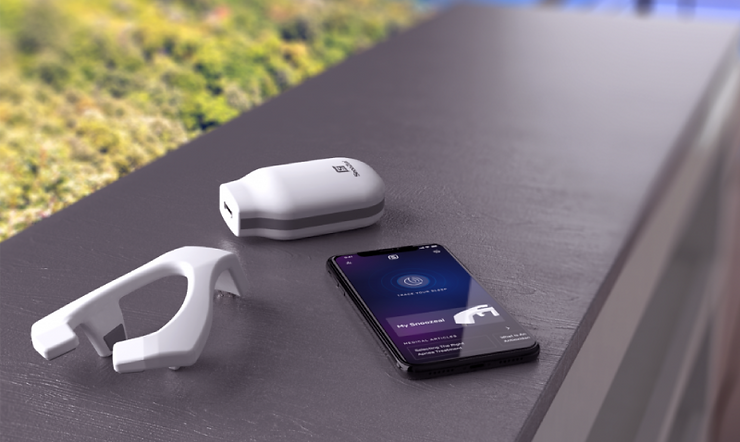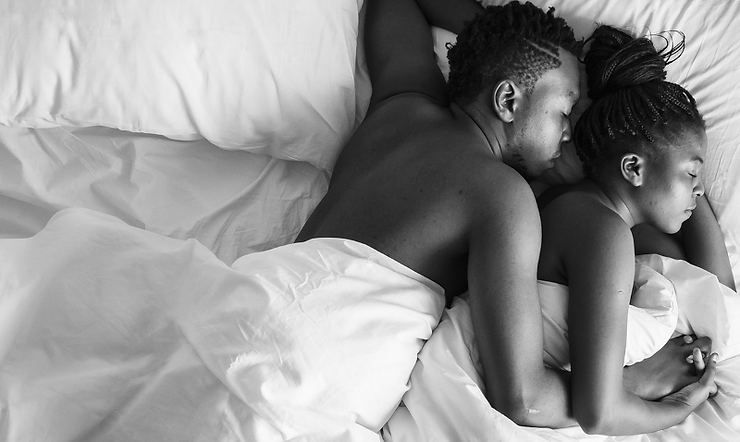GUIDE TO SLEEP APNEA TREATMENT
Explore your options for treating sleep apnea
Did you know that over 54 million people live with sleep apnea in the United States? And when you look worldwide, that number is close to 1 billion or double the number of people with diabetes! Despite the massive scale of this problem, most people with sleep apnea still aren’t diagnosed, and fewer still have started treatment.
If you consider sleep apnea treatment, how do you know which option is right for you? And with so many treatment choices available today, have you reviewed them all?
What are sleep apnea treatment options?
The most common sleep apnea treatment is a CPAP (continuous positive airway pressure) machine. Other treatments include an oral appliance, upper airway stimulation, positional therapy, and surgery among other options.
When left untreated, sleep apnea causes constant pauses in breathing, preventing you from getting oxygen to your heart and lungs. These repeated pauses are created by a partial or complete blockage of your airway. This blockage is often associated with:
-
the throat tissue collapsing
-
the tongue relaxing
-
the anatomical size of the airway
-
being overweight
-
reduced airflow caused by chronic nasal congestion
In addition to the lack of oxygen, this blockage also disrupts your sleep cycle. It results in daytime symptoms such as decreased energy levels, morning headaches, lower motivation, and a reduced sense of well-being. Over the long-term, untreated sleep apnea is linked to the increased health risk of developing severe conditions such as:
-
high blood pressure
-
heart disease
-
stroke
-
diabetes
-
depression
Given the negative health impact, it's essential to take your sleep apnea seriously and seek appropriate treatment. Treatment tries to address the underlying cause of sleep apnea so you can breathe normally throughout the night. But each option has a different approach to accomplish that. Let's review the various types of sleep apnea treatments currently available.
CPAP machine

A CPAP machine treats sleep apnea by delivering a continuous stream of air to create positive pressure in your airway and keep it open throughout the night so you can continue to breathe. The bedside CPAP machine is connected by a tube to a mask you wear at night.
There are several styles of masks, including those that go under the nose (nasal pillows), over the nose (nasal), and over the nose & mouth (full face). CPAP machines come in a variety of makes and models with some standard modes based on their function:
-
CPAP delivers one fixed pressure throughout the night
-
APAP provides an automatically adjusted pressure based on your breathing
-
BiPAP provides two fixed pressures - one for breathing in and one for breathing out
CPAP has been the gold standard treatment for sleep apnea since 1981, and the machines have come a long way in that time. Newer devices are barely louder than a whisper (and quieter than snoring!), and some models can be as small as a cell phone. Despite these advances, many people still struggle with CPAP machines due to comfort, noise, and breathing difficulty issues.
Oral appliance

Oral appliances for sleep apnea are dental devices worn in the mouth while you sleep. These oral appliances or mandibular advancement devices (MAD) fit over your teeth and work by repositioning your lower jaw to create a larger airway than usual. In some cases, these oral appliances need to be adjusted or “titrated” to find the best position for your jaw to reduce apneas or to snore sufficiently.
These devices range from a simple boil and bite design (similar to mouth guards) to custom-fitted oral appliances which your dentist can produce. The FDA has approved over 100 different oral appliances to treat sleep apnea.
Oral appliances are the second most common treatment for sleep apnea and have gained popularity since sleep dentists first introduced them in the late 1990s. Oral appliances are a popular choice because they are easy to wear and convenient to travel. However, they aren’t as effective as CPAP machines for all types of sleep apnea, and some users complain of jaw pain or permanent changes to their bite.
Upper airway stimulation

Upper airway stimulation or hyperglossal nerve stimulation works by activating the muscle response in your tongue and upper airway. A small device is implanted under the skin on your chest and neck. When you fall asleep, the machine begins to monitor your breathing and, on each breath, stimulates the throat muscles with a small electric pulse. The stimulation causes the muscles to contract and the airway to remain open.
Implanting the device is a simple same-day surgical procedure with a relatively quick recovery time. However, specific qualifications are required to be eligible for this treatment, including:
-
Over the age of 22
-
Body mass index (BMI) below 33
-
Moderate to severe sleep apnea (AHI 15 to 65 events/hour)
-
Unable to use a CPAP machine after trying
This therapy solution is a relative newcomer with the first device, Inspire Sleep, receiving FDA approval in 2014.[13] Inspire Sleep doesn’t require you to wear a mask, mouth guard, or anything else. Aside from the general risks for surgery, people complain of pain or discomfort in the tongue from the constant stimulation.
Positional therapy

For some people, their sleep apnea depends on the position they sleep in - often on their back or the "supine" position. Positional therapy uses various techniques to get you to move to your side or stomach from your back when you start sleeping in that position.
Positional therapy solutions include several options:
-
Home remedies such as a tennis ball or piece of foam strapped to your back to prevent you from sleeping in that position
-
Specialized shirts or belts which make it difficult to sleep on your back
-
Devices that monitor your sleeping position or snoring while you sleep and give you a gentle nudge or vibration to help you move
While simple home remedies have been around for a while, the number of "smart" solutions has increased dramatically in recent years. These solutions are discreet and easy to wear for those suffering from positional sleep apnea. However, they won't work for everyone depending on the condition's underlying cause.
Surgery

Surgical procedures can be an option for those who can’t tolerate other sleep apnea treatments. The goal of surgery is to remove or reposition the tissue around the airway that blocks your breathing. This can include your soft palate, uvula, tonsils, adenoids, tongue, or even your jaw. The different types of surgery include:
-
Septoplasty or sinus surgery
-
Surgery to your soft palate or uvula called UPPP
-
Surgery to bring your tongue forward
-
Surgery to move your hyoid bone
-
Jaw surgery called maxillomandibular osteotomy and advancement
-
Fiber rod implants called palatal implants
-
Laser or radio-frequency treatment
Surgery for sleep apnea isn’t always successful depending on the underlying cause, and there is always the potential for complications such as chronic pain, bleeding and infection. In some cases the benefits from surgery will be temporary and the symptoms of sleep apnea can return.
EPAP therapy

A small, one-way valve covers your nose in EPAP (or expiratory positive airway pressure) therapy. When you breathe in, air enters the nose typically. However, when you breathe out, the valve closes and reduces the airflow. This one-way valve generates positive pressure in your airway, helping it stay open and reducing the number of apneas.
EPAP therapy is an excellent option for those looking for an alternative therapy to CPAP and want something convenient, disposable, and easy to travel. However, because the device requires you to breathe through your nose, EPAP therapy isn’t great for those who breathe through their mouth or suffer frequent nasal congestion.
Medication

To date, there’s no official medication indicated for sleep apnea treatment. Several dietary supplements have been used to remedy the symptoms associated with sleep apnea, such as congestion, alertness, or others. However, nutritional supplements are largely unregulated and haven’t proven clinically effective. Consult your healthcare professional before seeking alternative medicine solutions.
Recently, there has been promising research regarding a new combination of drugs. This combination was shown to reduce the number of disturbed breathing events per hour in the people studied. Further clinical testing is necessary to confirm these results.
Weight loss

Sleep apnea is often linked to being overweight, and taking steps to lose weight can help address the symptoms and underlying cause. Weight loss has been shown to reduce the severity of sleep apnea and, in some cases, completely resolve apneas and reduce the likelihood of developing type 2 diabetes, reduce blood pressure, and improve quality of life.
Overall a healthy eating habit combined with regular exercise has been shown to help reduce weight and could lessen the severity of sleep apnea along with other chronic conditions. In addition, weight loss can help improve the efficacy of other sleep apnea treatments.
Tongue stabilizing device

Another type of oral solution is a tongue stabilizing device that works by attaching to your tongue, usually through suction. While you sleep, it gently pulls your tongue forward and keeps it from blocking your airway.
The FDA has not approved tongue stabilizing devices to treat sleep apnea. However, they are effective in individuals with snoring and are currently in clinical trials to prove their efficacy for sleep apnea.
Snoring exercises

Since sleep apnea is often linked to the tissue or muscle around your airway collapsing, there are ways in which you can strengthen those muscles. These exercise routines reduce the likelihood of your airway closing while you sleep and also lessen the severity of your snoring.
Historically, this muscle strengthening could be accomplished through specific exercises or playing instruments, such as the didgeridoo, to build that strength. Recently, there has been a device in development that automates this tongue strengthening routine through low-intensity electrical pulses. The device, Snoozeal, is used during the day for roughly 20 minutes and during this time the electrical pulses strengthen the muscles in your tongue. The FDA approved this device in 2021.
Strengthening these muscles doesn’t require you to wear a mask, mouth guard, or anything else overnight. However, it typically won’t be fully successful in treating sleep apnea on its own.
Lifestyle changes

In addition to weight loss, other unhealthy habits can hurt your sleep. These include frequent alcohol use and smoking. Alcohol is a depressant, and when you drink, it reduces the muscle tone in your airway and increases the likelihood of it becoming blocked.
Smoking is a known irritant that causes your throat and airway to inflame. This inflammation or swelling can narrow the airway and increase the likelihood of the airway closing. Smoking has also been shown to impact your blood’s ability to retain oxygen, making the lack of oxygen in sleep apnea patients even worse.
CNEP therapy

CNEP (or continuous negative external pressure) therapy works by creating a vacuum or negative pressure on the outside of your jaw and neck to pull the tissue forward and prevent it from collapsing during sleep. A flexible, silicone collar is worn on the neck with a small pump attached to create a vacuum and pull the tissue forward quietly.
The first device, the aerSleep, was released in 2018 in Canada to treat sleep apnea but is not approved by the FDA. The aerSleep system doesn't require a connection to an external machine and isn't worn on the face or mouth. However, some users complain of discomfort from the collar, and active sleepers may have difficulty keeping the device in place.
Oral pressure therapy

Oral pressure therapy combines several of the sleep apnea treatment options listed above. Oral pressure therapy uses negative pressure or suction to keep the soft palate tissue, and tongue pulled forward to keep your airway open throughout the night. Suction is created by a small bedside machine connected by a small tube to a mouth guard you wear while you sleep.
The Winx Sleep Therapy System, from ApniCure, was the first oral pressure therapy system after receiving FDA approval in 2012. Compared to a CPAP machine, the Winx system didn’t require a mask or headgear despite a bedside machine. However, in 2017, ApniCure went out of business, and the Winx system is no longer available for purchase.
Micro CPAP

The micro-CPAP promises to deliver the benefits of CPAP therapy without a mask, hose, or cord. The device sits under the nose and uses an array of micro-blowers to provide the full range of treatment pressures. The device should last one night before being discarded using an included battery.
The micro-CPAP was introduced to the world in 2015 through a successful crowdfunding effort on Indiegogo, which raised almost $2 million. Now, many years later, Airing Inc. has yet to release its product to the market, citing development challenges. Many “knock-off” micro-CPAP solutions can be found online, though, which are nothing more than plastic shells with foam inside.
Summary

Once you start treating your sleep apnea, you’ll begin to feel more refreshed, more awake, and begin to reduce the negative symptoms of untreated sleep apnea. In addition, you’ll be reducing your risk of developing other chronic diseases and conditions associated with untreated sleep apnea.
With so many sleep apnea treatments available it can be difficult to know which solution is right for you. If you need help selecting the right option, speak to your primary care physician or sleep physician. They’ll help you assess your condition, your therapy goals, and ultimately which sleep apnea treatment is best for you.





